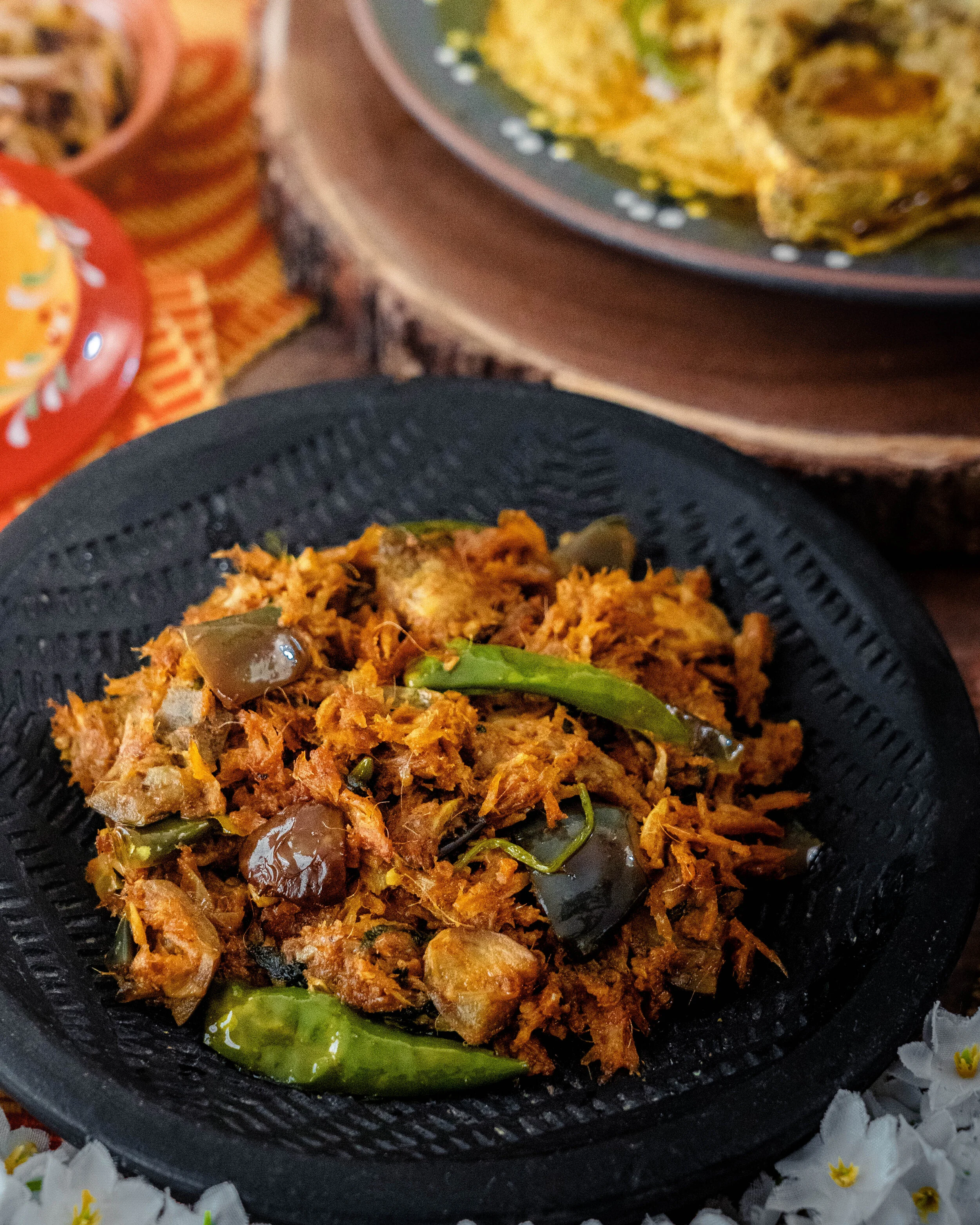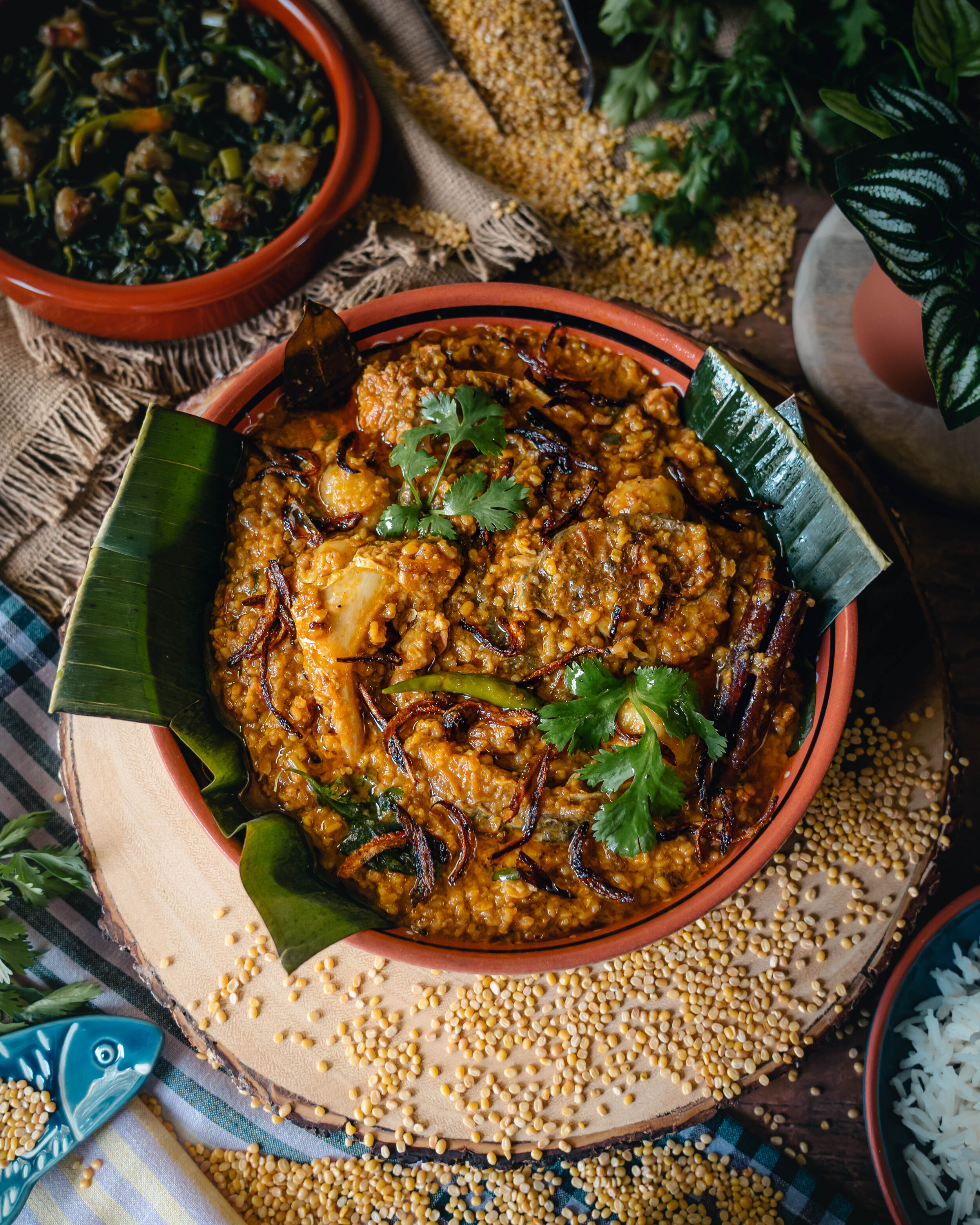Loitta Shutki Bhuna

The fiery flavors of shutki, dried and fermented fish is an important aspect of life in Bangladesh, from the change of time and tide to the heat of the spices. There is a lot to say about the history and the preservation techniques of shutki. But first let me explain what it is — shutki refers to fish that has been either dried, salted, preserved or fermented.
The smell of shutki is very strong and it might be off-putting for some. But for those who grew up eating it, this is an acquired taste. Just like smoked salmon or gravlax is a delicacy, so is shutki to many Bangladeshis. This is especially true in the southern and coastal regions of the country where fish comes in abundance.
What is Shutki?
Shutki refers to a variety of freshly caught fish that are preserved using different methods such as sun-dried, smoked, and salted. The preservation method can span multiple days in order for the fish to lose all the moisture and have a well-extended shelf life. The preparations and cooking of shutki is is notable for the strong (sometimes putrid) smell.
What is the purpose of Shutki?
Fish rapidly spoils, or goes rotten, unless some method is applied to stop the bacteria that produce the spoilage. Historically speaking, before refrigeration, canning and other modern preservation techniques became available, people from the Indian subcontinent, especially coastal regions like the Bengal, South India and Sri Lanka used techniques like drying and fermenting to preserve fish. Nowadays, there are many other techniques of preserving fish, but fish is still dried and fermented because some people enjoy the taste.
Why is Shutki such a polarizing ingredient?
It is polarizing because a lot of people do not understand the preservation and preparation that goes behind creating shutki. Contrary to some ignorant mindset, shutki is not rotten or decayed fish. Then there are also some out of touch self-hating Bengalis who think shutki is food for those who can’t afford to buy fresh fish. It’s a pity that there is so much social stigma attached to such a wonderful ingredient.
What about the smell?
What about it?! Yes, it has a funky smell but so do delicacies from so many other cultures. I have a lot of personal feelings and opinions about the racial dynamics of “smelly food”. America’s anti-Asian bigotry has a very old stench, pun intended. And a lot of us first and second generation immigrants have unknowingly absorbed and assimilated into this white supremacist culinary standards. But if you ponder for a minute, there are plenty of “white” foods that have a strange scent to them as well.
There are so many strong-smelling and strange ingredients that come from the Global North which we have learned to accept, love and even relish. Here is a list of some I can think off the top of my head — rocky mountain oysters (North America), blue cheese (France), haggis (Scotland), salami and anchovies (Italy), lutefisk (Norway), surströmming (Sweden) and so on.
Then why do food like shutki, kimchi, durian fruit, natto, century eggs, shrimp paste, fish sauce and many staple Asian ingredients get so much hate? Why do you as a child of immigrants hate on delicacies from your own culture? Ask yourself, is your dislike of “smelly” food from the global south actually unchecked cultural intolerance and feeling ashamed towards your own ethnic roots?
Look, I understand if it’s something you can’t eat, that you have made previous attempts and it’s just not for you. But it’s time we shift our attitudes towards diverse foods and increase our awareness of cultural practices, it’s time we unravel our subconscious prejudice towards ourselves and others.
Dried + Fermented Fish in Other Cultures
In my attempt to break the shame and stigma as well as unmask the racial micro-aggression towards cultural food, I am going to share many other ways fish is preserved and prepared around the world.
Kipper | Great Britain, USA, Canada
Fish Sauce | Asia
Canned Anchovies | Europe
Gravlax, Smoked Salmon | Nordic
Belacan/Terasi | Malaysia & Indonesia
Katsuobushi | Japan
Jeotgal | Korea
Hákarl | Iceland
Surströmming | Sweden
There is plenty more! If you are interested, you can read all about dried fish and fermented fish.
Recipe — Loitta Shutki Bhuna | Dry Bombay Duck Curry
Serves: 4-6
Traditionally, the main ingredient in this recipe is shutki made from Loitta which is Bombay Duck fish, common in the Bay of Bengal and in the South China Sea. You should be able to find dried or frozen Bombay duck fish at your local Bangladeshi or Indian grocery stores.
If you want to make this recipe, but can’t find this particular fish, other types of dried fish will also work, the Southeast Asian Belacan is a great alternative. Aside from dried fish, you could also use any fresh fish fillets like cod, halibut or canned fish like tuna or salmon. In essence, this is a dry stir fry of fermented or fresh fish with eggplants.
Loitta Shutki - 2 cups
Remove the heads and tails, and cut the fish into 2 inch pieces. Dry saute them slightly in a pan without any oil, then soak the pieces in hot water for about an hour. While soaking, clean the pieces thoroughly a few times in water to remove any scales and dirt from the skin as well as make the fish softer. Try to clean the fish gently so it doesn’t disintegrate. Strain the fish very well, making sure to remove any water. Set it aside.
Note: If you are using any other type of dried fish, fresh fish, or canned fish, follow the package direction of how to clean them (if they need cleaning).
Oil - ½ cup
Onions - ½ cup, sliced
Garlic - 2 tsp
Ginger Paste - 1 tsp
Turmeric - 1 tsp
Red Chili Powder - 2 tsp
Ground Coriander - 2 tsp
Ground Cumin - 2 tsp
Salt - 1 tsp
Heat oil in a skillet or frying pan over medium heat. Add the onions until slightly translucent. Add the garlic paste, ginger paste, turmeric, red chili powder, coriander, cumin powder, turmeric, and salt. Stir everything making sure the spices don’t burn. Add a splash of water if needed.
Once the aromatics and spices are completely cooked, raw smell has dissipated and oil starts to shimmer and pool on the side, add the fish pieces. Mix thoroughly, turn the heat down to medium-low, cover the lid and let it cook for 5 minutes.
Indian Eggplants - 6, cut into 4 inch pieces
Garlic Cloves - 3-4, cut into thin slices
Indian/Thai Green Chilies - 4-5 or more
Note: Indian eggplants are the little baby purple eggplants. If you can’t find them, the green Thai eggplants will also work. Otherwise use 1 chinese eggplants or half an Italian eggplants.
Add the eggplants, garlic slices and green chilies. Mix thoroughly and continue to cook over low heat. Once everything seems to have melded together, the eggplants have softened a little bit, add ¼ cup warm water, turn the heat up to medium and cover the lid for another 5 minutes or until the water has dried up. Make sure to stir in between so the bottom doesn’t burn.
Roasted Cumin Powder - 1 tsp
Cilantro Leaves - chopped
Once the water has completely dried up, the eggplants are cooked and the fish pieces fried, turn off the heat. Sprinkle roasted cumin powder and cilantro leaves. Combine everything one more time, turn off the heat and cover the lid until ready to serve.








